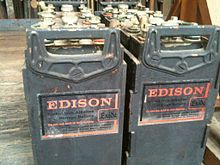Nickel–iron battery
Appearance
 Nickel–iron batteries manufactured between 1972 and 1975 under the "Exide" brand originally developed in 1901 by Thomas Edison. | |
| Speceefic energy | 19-25 [1] Wh/kg |
|---|---|
| Energy density | 30 Wh/l |
| Speceefic pouer | 100[2] W/kg |
| Chairge/dischairge efficiency | <65%[3] |
| Energy/consumer-price | 1.5 – 6.6[2] Wh/US$ |
| Sel-dischairge rate | 20%[2] – 30%[2]/month |
| Time durability | 30[3] – 50 years[4] |
| Cycle durability | Repeated deep discharge does not reduce life significantly.[3] |
| Nominal cell voltage | 1.2 V[2] |
| Chairge temperatur interval | min. −40 °C – max.46 °C[5] |
The nickel–iron battery (NiFe battery) is a rechairgeable battery haein nickel(III) oxide-hydroxide positive plates an airn negative plates, wi an electrolyte o potassium hydroxide. The active materials are held in nickel-plated steel tubes or perforated pockets. It is a very robust battery which is tolerant o abuse, (overcharge, overdischarge, an short-circuiting) an can hae very lang life even if sae treatit.[6] It is eften uised in backup situations whaur it can be continuously charged an can last for mair nor 20 years. Due tae its law specific energy, poor charge retention, an heich cost o manufacture, ither types o rechairgeable batteries hae displaced the nickel–iron battery in maist applications.
References
[eedit | eedit soorce]- ↑ "Energy Density from NREL Testing by Iron Edison". Archived frae the original (PDF) on 20 October 2016. Retrieved 25 Mairch 2014.
- ↑ a b c d e "mpoweruk.com: Accumulator and battery comparisons (pdf)" (PDF). Archived frae the original (PDF) on 29 Mairch 2018. Retrieved 25 Apryle 2018.
- ↑ a b c "Mpower: Nickel Iron Batteries". Archived frae the original on 26 August 2018. Retrieved 25 Apryle 2018.
- ↑ ""Nickel Iron Battery Frequently Asked Questions" BeUtilityFree". Archived frae the original on 21 Februar 2016. Retrieved 25 Apryle 2018.
- ↑ Web archive backup: Edison Battery Booklet original instruction book for the Edison battery
- ↑ David Linden, Thomas B. Reddy (ed). Handbook Of Batteries 3rd Edition, McGraw-Hill, New York, 2002 ISBN 0-07-135978-8, Chapter 25
